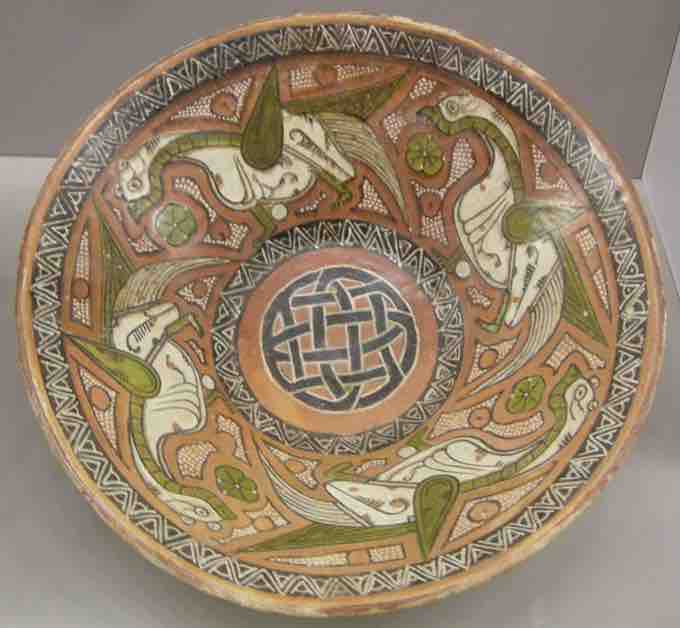Islamic art has notable achievements in ceramics, both in pottery and tiles for buildings, which reached heights unmatched by other cultures. Early pottery had usually been unglazed, but a tin-opacified glazing technique was developed by Islamic potters. The first Islamic opaque glazes can be found as blue-painted ware in Basra, dating to around the 8th century. Another significant contribution was the development of stonepaste ceramics, originating from 9th century Iraq. The first industrial complex for glass and pottery production was built in Ar-Raqqah, Syria, in the 8th century. Other centers for innovative pottery in the Islamic world included Fustat (from 975 to 1075), Damascus (from 1100 to around 1600), and Tabriz (from 1470 to 1550). Lusterware is a type of pottery or porcelain having an iridescent metallic glaze. Luster first began as a painting technique in glass making which was than translated to pottery in Mesopotamia in the 9th century.

10th Century Dish, East Persia or Central Asia
Islamic art has very notable achievements in ceramics, both in pottery and tiles for walls, which reached heights unmatched by other cultures.
Techniques, shapes, and decorative motifs of Chinese ceramics were admired and emulated by Islamic potters, especially after the Mongol and Timurid invasions. Until the Early Modern period, Western ceramics had little influence, but Islamic pottery was highly sought after in Europe, and was often copied. An example of this is the albarello, a type of earthenware jar originally designed to hold apothecary ointments and dry drugs. The development of this type of pharmacy jar had its roots in the Islamic Middle East. Hispano-Moresque examples were exported to Italy, inspiring the earliest Italian examples, from 15th century Florence.
The Hispano-Moresque style emerged in Al-Andaluz, or Muslim Spain, in the 8th century, under Egyptian influence. More refined production happened much later, presumably by Muslim potters working in areas reconquered by Christian kingdoms. The Hispano-Moresque style mixed Islamic and European elements in its designs and was exported to neighboring European countries. The style introduced two ceramic techniques to Europe: glazing with an opaque white tin-glaze and painting in metallic lusters. Ottoman Iznik pottery produced most of the finest ceramics of the 16th century, in tiles and large vessels boldly decorated with floral motifs influenced by Chinese Yuan and Ming ceramics. These were still in earthenware, since porcelain was not made in Islamic countries until modern times. The medieval Islamic world also painted pottery with animal and human imagery, with examples found throughout the medieval Islamic world, particularly in Persia and Egypt.